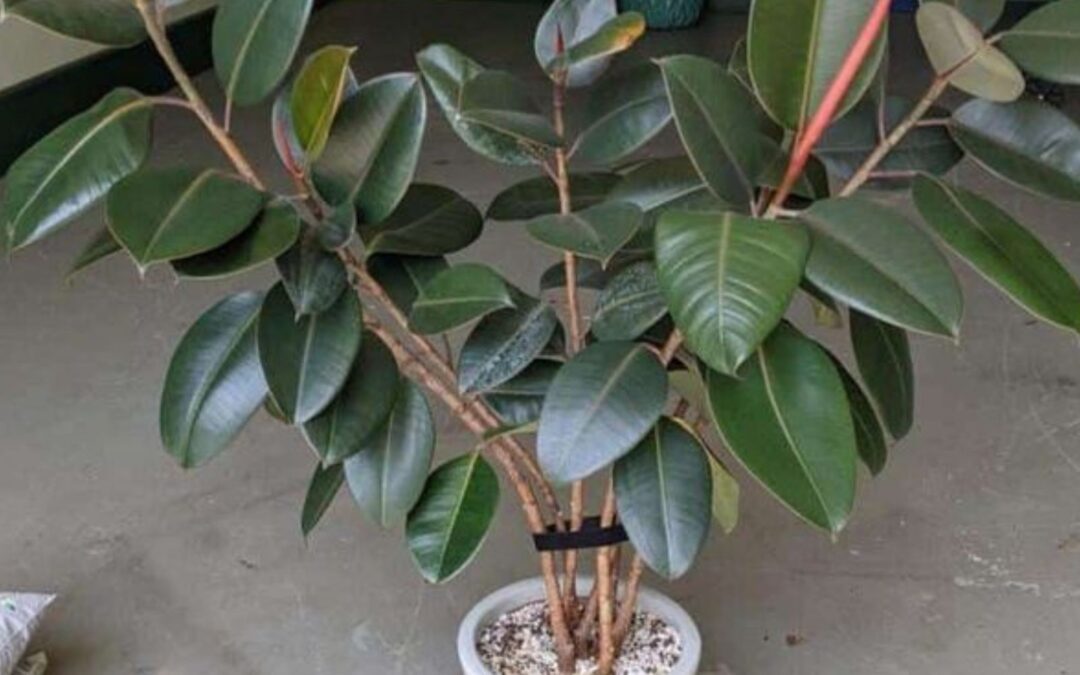Introduction
Are you ready to bring a touch of the tropics into your home? The rubber plant, with its glossy leaves and striking presence, is not just an eye-catching addition to your space; it’s also relatively easy to care for. Whether you’re a seasoned plant parent or new to indoor gardening, this ultimate guide will equip you with everything you need to know about nurturing your rubber plant. From light requirements to seasonal care tips, we’ve got all the insights that will help your rubber plant thrive and flourish. Let’s dive in!
The Ultimate Guide to Caring for Your Rubber Plant: Tips and Tricks

Caring for a rubber plant is simpler than you might think. These hardy beauties can adapt to various indoor conditions but thrive with the right attention. Start by placing your rubber plant in a spot that enjoys ample indirect sunlight, enhancing its vibrant foliage.
Watering is key; let the top inch of soil dry out before giving it a drink. Ensure proper drainage to prevent root rot.
Pruning helps maintain shape and encourages new growth, so don’t hesitate to trim back unruly branches. Fertilizing every few weeks during the growing season will give your rubber plant an extra boost, making it flourish beautifully in your living space!
About Rubber Plants
Rubber plants, scientifically known as Ficus elastica, are popular houseplants loved for their glossy leaves and easy care. Native to Southeast Asia, they can grow quite tall in the right conditions. Their thick stems and broad foliage make them an attractive choice for both beginners and experienced plant enthusiasts.
These versatile plants come in various varieties, showcasing different leaf colors and patterns. Rubber plants thrive in indoor environments but also adapt well outdoors in warm climates. Their ability to purify the air adds extra appeal.
Beyond aesthetics, rubber plants symbolize resilience and growth. They’re often seen as a positive addition to home decor or office spaces, promoting a sense of tranquility while enhancing any environment.
How Much Light Does a Rubber Plant Need?
Rubber plants thrive in bright, indirect light. They can adapt to lower light conditions but may grow more slowly and lose their vibrant color. Ideally, aim for a spot where they receive filtered sunlight.
If your rubber plant gets too much direct sun, the leaves might scorch or develop brown spots. Observing your plant closely will help you determine if it’s getting just the right amount of light.
Rotating the pot occasionally ensures all sides receive equal exposure. This practice promotes balanced growth and prevents lopsided development. Keep an eye on how your rubber plant responds to its environment; adjusting the lighting can make a significant difference in its health.
What Kind of Light Does a Rubber Plant Need?

Rubber plants thrive in bright, indirect light. They can tolerate lower light conditions but may not grow as vigorously. The more light they receive, the faster and healthier they’ll grow.
Direct sunlight can be harmful. It often leads to scorched leaves or brown spots, which is something every plant owner wants to avoid. Ideally, place your rubber plant near a window with filtered light.
If you notice stretching or leggy growth, it’s likely craving more brightness. A simple rotation of the pot can help ensure even exposure to available light sources for balanced growth throughout the plant’s structure.
Signs of Overexposure to Direct Sunlight
Rubber plants thrive in bright, indirect light but can suffer from overexposure to direct sunlight. One of the first signs is leaf burn. You may notice brown or crispy patches forming on the edges and surfaces of leaves.
Another indicator is fading color. Healthy rubber plant leaves have deep green foliage, but prolonged sun exposure can lead to a washed-out appearance. If your usually vibrant plant looks dull, it could be struggling with too much sun.
Wilting or drooping leaves are common symptoms. When a rubber plant receives excessive sunlight, it can become stressed and lose its vitality. Keeping an eye on these signs will help you maintain a healthy rubber plant environment.
Seasonal Care Tips for Rubber Plants
Rubber plants thrive with seasonal adjustments. During spring and summer, they flourish in warm temperatures and benefit from frequent watering. Make sure the top inch of soil dries out between waterings to avoid overwatering.
As autumn approaches, gradually reduce watering frequency. Rubber plants need less moisture as growth slows down in cooler weather. Ensure they still receive ample indirect sunlight during this transition.
In winter, protect your rubber plant from cold drafts. Keep them in a stable environment away from heaters or windows that may cause temperature fluctuations. Water sparingly, allowing the soil to dry out more than usual before re-watering to prevent root rot.
Taking Care of Rubber Plants in Summer
Summer brings warmth and sunlight, which can be both a blessing and a challenge for your rubber plant. During this season, ensure that your plant receives bright, indirect light to thrive without getting scorched. Placing it near east-facing windows is ideal.
Watering becomes crucial in the summer months as the heat can dry out the soil quickly. Check moisture levels regularly and water when the top inch of soil feels dry. Be careful not to overwater; soggy roots are detrimental.
Humidity also plays an essential role in summer care. Rubber plants enjoy humidity, so misting their leaves or using a pebble tray with water can help keep them happy during hot spells.
Caring for Rubber Plants in Winter
During winter, your Rubber Plant needs extra attention. The cooler temperatures can affect its growth and overall health. Keep the plant in a warm spot, away from chilly drafts or heating vents.
Reduce watering during these months. The colder air slows down its growth, meaning less frequent moisture is required. Allow the soil to dry out between waterings to prevent root rot.
Humidity is often lower indoors during winter. Consider misting your Rubber Plant occasionally or using a humidity tray to maintain adequate moisture levels in the air around it. This will keep your plant happy and thriving even when it’s cold outside.
FAQs on Rubber Plant Light Needs
Rubber plants thrive in bright, indirect light. Many plant owners wonder if their rubber plants can adapt to lower light conditions. While these resilient plants can survive in partial shade, they may not grow as vigorously or develop their signature glossy leaves.
Another common question is whether direct sunlight is harmful. Yes, it can be! Too much direct sun exposure leads to scorched leaves and fading colors. Always monitor your plant’s response to its environment.
People often ask about seasonal changes affecting light needs. During winter months, when natural light decreases, consider moving your rubber plant closer to a window for optimal growth while avoiding drafts that could affect its health.
Potting Your Rubber Plant
Potting your rubber plant is essential for its health and growth. A well-draining potting mix helps prevent root rot, which can be detrimental to the plant’s vitality. Choose a pot that is slightly larger than the current one, allowing room for growth without overwhelming the roots.
When repotting, gently loosen any tightly bound roots before placing them in fresh soil. Ensure that the new pot has drainage holes to allow excess water to escape easily. This step will help maintain optimal moisture levels.
After potting, give your rubber plant time to adjust in a location with indirect light. Monitor it closely over the next few weeks as it acclimates to its new environment.
Watering Your Rubber Plant
Watering your rubber plant requires a delicate balance. Allow the top inch of soil to dry out between waterings. This prevents root rot while keeping your plant hydrated.
During active growth in spring and summer, you may need to water more frequently. Always check for moisture by sticking your finger into the soil. If it feels dry, it’s time to give your rubber plant a drink.
In fall and winter, reduce watering as growth slows down. Too much moisture can lead to issues like yellowing leaves or drooping foliage. Adjust accordingly based on the season for healthy growth.
Pruning and Maintenance
Pruning your rubber plant is essential for promoting healthy growth. Start by removing any dead or yellowing leaves. This not only improves the plant’s appearance but also prevents disease.
You can also trim back leggy stems to encourage bushier growth. Aim to cut just above a leaf node, as this will help stimulate new branch development.
Regular maintenance is key too. Dust the leaves occasionally with a damp cloth to keep them clean and enable optimal photosynthesis. Check for pests and diseases regularly; early detection makes treatment easier and more effective.
Fertilizing Your Rubber Plant
Fertilizing your rubber plant is essential for its health and growth. Use a balanced, water-soluble fertilizer that’s high in nitrogen during the growing season. This promotes lush foliage and vibrant leaves.
Apply fertilizer every 4-6 weeks from spring through early fall. Always dilute it to half strength to prevent root burn. Pay attention to how your plant responds; if you notice yellowing leaves, you may need to adjust the frequency or concentration.
In winter, reduce fertilization significantly as the plant enters dormancy. A little goes a long way during this period since growth slows down considerably. Keep an eye on your rubber plant’s needs throughout the year for best results.
Troubleshooting Common Problems
Rubber plants are generally resilient, but they can face some challenges. Yellowing leaves often signal overwatering. Check the soil; if it’s soggy, reduce your watering frequency.
Brown leaf edges might indicate underwatering or low humidity levels. Increase humidity with a pebble tray or misting to bring back that lush green look.
Pests like spider mites and scale insects can also invade your rubber plant. Regularly inspect the leaves for any signs of trouble. If you notice pests, treat them promptly with insecticidal soap or neem oil to keep your plant healthy and thriving.
Propagating Your Rubber Plant

Propagating your rubber plant is a rewarding process. You can easily grow new plants from cuttings. Choose a healthy stem with several leaves, ideally around 6 inches long.
Using clean, sharp scissors, cut just below a leaf node. Remove the lower leaves to prevent rot when placed in water or soil. Both methods work well; however, water propagation allows you to see root growth.
Place the cutting in bright but indirect light for best results. Change the water every few days if propagates in the water. For soil propagation, keep it moist but not soggy, and watch for growth over time!
Indoor vs. Outdoor Care for Rubber Plants
When it comes to caring for your rubber plant, whether indoors or outdoors, the approach varies slightly. Indoor rubber plants thrive in stable conditions with indirect sunlight and controlled humidity. Make sure they’re placed near windows but shielded from direct rays.
Outdoor rubber plants enjoy the warmth of bright light and can adapt to partial shade. However, it’s crucial to protect them from harsh wind and cold temperatures. Adjust the watering frequency based on rainfall and temperature fluctuations.
Both settings require regular monitoring for pests and overall health. With proper attention, your rubber plant will flourish beautifully regardless of its location. Embrace the journey of nurturing this stunning houseplant!

